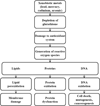Metal pollutants and cardiovascular disease: mechanisms and consequences of exposure
- PMID: 25458643
- PMCID: PMC4254412
- DOI: 10.1016/j.ahj.2014.07.007
Metal pollutants and cardiovascular disease: mechanisms and consequences of exposure
Abstract
Introduction: There is epidemiological evidence that metal contaminants may play a role in the development of atherosclerosis and its complications. Moreover, a recent clinical trial of a metal chelator had a surprisingly positive result in reducing cardiovascular events in a secondary prevention population, strengthening the link between metal exposure and cardiovascular disease (CVD). This is, therefore, an opportune moment to review evidence that exposure to metal pollutants, such as arsenic, lead, cadmium, and mercury, is a significant risk factor for CVD.
Methods: We reviewed the English-speaking medical literature to assess and present the epidemiological evidence that 4 metals having no role in the human body (xenobiotic), mercury, lead, cadmium, and arsenic, have epidemiologic and mechanistic links to atherosclerosis and CVD. Moreover, we briefly review how the results of the Trial to Assess Chelation Therapy (TACT) strengthen the link between atherosclerosis and xenobiotic metal contamination in humans.
Conclusions: There is strong evidence that xenobiotic metal contamination is linked to atherosclerotic disease and is a modifiable risk factor.
Copyright © 2014 The Authors. Published by Elsevier Inc. All rights reserved.
Figures





References
-
- Agency for Toxic Substances and Disease Registry (ATSDR) The priority list of hazardous substances. Atlanta (GA): U.S. Department of Health and Human Services, Public Health Service; 2011.
-
- Abadin H, Ashizawa A, Stevens YW, Llados F, Diamond G, Sage G, et al. Toxicological Profile for Lead. Atlanta (GA): 2007. Agency for Toxic Substances and Disease Registry (ATSDR) Toxicological Profiles. - PubMed
-
- Skerfving S, Bergdahl IA. Lead. In: Nordberg GF, Fowler BA, Nordberg M, Friberg LT, editors. Third Edition. Elsevier: Handbook on the Toxicology of Metals; 2007. pp. 599–643.
-
- Chisolm JJ, Jr., Harrison HE. The exposure of children to lead. Pediatrics. 1956;18(6):943–958. - PubMed
-
- Papanikolaou NC, Hatzidaki EG, Belivanis S, Tzanakakis GN, Tsatsakis AM. Lead toxicity update. A brief review. Medical science monitor : international medical journal of experimental and clinical research. 2005;11(10):RA329–RA336. - PubMed
Publication types
MeSH terms
Substances
Grants and funding
LinkOut - more resources
Full Text Sources
Other Literature Sources

